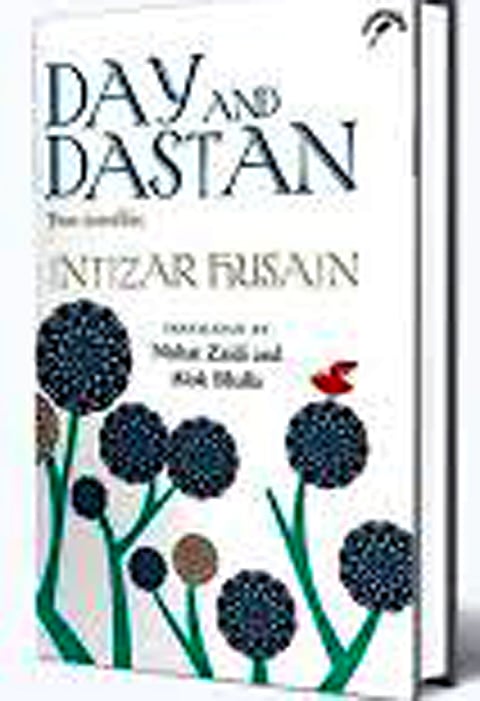
- Home
- Live Blog
- Breaking News
- Top Headlines
- Cities
- NE News
- Sentinel Media
- Sports
- Education
- Jobs

Book Review
Mohammed Shafeeq
Day and Dastan (Two novellas) by Intizar Husain; Translated by: Nishat Zaidi and Alok Bhalla
"Din Aur Dastan" is one of the more famous works of Intizar Husain. Nearly six decades after this India-born Pakistani Urdu writer penned the two novellas, Nishat Zaidi and Alok Bhalla have come out with its translation for English-speaking readers. This is a remarkable juxtaposition of two distinct styles of storey-telling Intizar was known for. “Day” is the realistic story of a feudal joint family, a story steeped in the nostalgia of personal past yet a symbolic reference to the trauma caused by India’s Partition. In “Dastan”, Husain exhibits fictional inventiveness to narrate through surrealistic imagery stories in the backdrop of the 1857 War of Independence.
The partition of India was one event which had a huge impact on Urdu literature and with Intizar Husain himself being the creation of partition as a writer, nobody else could have given a more realistic account of the cruellest of the events. One of the most celebrated writers in contemporary India and Pakistan, much of his fiction was on memories of his boyhood, a ‘qasba’ in Bulandshahr district of Uttar Pradesh, and the tragedy of partition. One of his famous novels, “Basti”, written in 1979 against the backdrop of partition, was shortlisted for the Man Booker International Prize in 2013 after it was translated into English by Frances Pritchett. He was the first Pakistani and the first Urdu writer ever to be nominated for the international award.
One of the well-known faces of modernist movement of Urdu literature, Husain was recipient of Sitara-e-Imtiaz (Star of Excellence), Pakistan’s third-highest civilian award. In 2012, he was given Life Time Achievement Award at Lahore Literary Festival while in 2014 he was given the French Officer de L’Ordre des Arts et des Letters award for his achievements. He passed away in 2016 at the age of 93. Like most of his fiction, “Day” captures the life in the backdrop of communal harmony, a culture in which the writer grew up. Husain’s detractors had always accused him of being in Pakistan temporally but mentally craving an earlier life and culture in India.
“Day” is the story of Zamir and his cousin Tahsina, their growing up together, his return to the town, their repressed emotions, the family losing their ancestral haveli in a law suit, his father’s decision to build a new kothi on the town’s periphery, the family shifting all its belongings to the kothi even before it was completed and the refusal of Tahsina’s mother to shift to the kothi. As Nishat Zaidi writes in her introduction, the novella refrains from making any direct reference to the Partition and the trauma of migration but it does deal with a world changed by it. Like Husain’s other works, “Day” also captures the daily life in vivid details like the streets, temple, trees, flowers, colour-changing chameleons and insects. The other novella, “Dastan”, is a traditional tale of wonder. Through his surrealistic symbolism and his mythological spin, he created authentic narratives to revisit the tragic events of 1857.
The ethical question in Husain’s stories is not anthropocentrically frames, but rather encompasses the flora and fauna; the entire landscape, and all things living and dead, writes Zaidi. “The ecosystem exists contiguously with the human world. It is not a metaphor. Human and non-human agents are part of one scene, wherein they exist separately and yet act upon each other, forming one syntag,” Zaidi writes. She quotes Husain as saying that unlike ancient stories which thrived on communication between humans and non-humans, and in which man appeared as part of the universe, the new-age storeyteller began to write tales of only the human world. “The tragic outcome of this loss of the non-human is that man himself metamorphosed into a demon, Zaidi writes.
To this extent the presence of the non-human is more pronounced in “Dastan”, written in two parts “The thunder of rivers” and “The screams of the horse”. “Through the novella, facts and historical events are woven into the essential threads of Dastan, that is Ramz (war), Bazm (assembly), Husn-o-Ishq (beauty and love) and Tilsim (enchantment),” Zaidi points out. It has a mysterious black river which forces the gallant to jump into its dark waters, a throbbing desert and a rotating tower, an empty city with vacant houses, faqirs who mysteriously appear and disappear, a horse whose neighing foretells events and a parrot that shows direction. Husain construed Islamic history as continuum by tracing back post-Partition crisis to the desolation of rebel soldiers of 1857 lead by Bakht Khan, anti-British battles of Haider Ali and Tipu Sultan, the glorious reign of Shershah Suri, and finally back to the martyrdom of Imam Hussain in the battle of Karbala, Zaidi noted. (IANS)